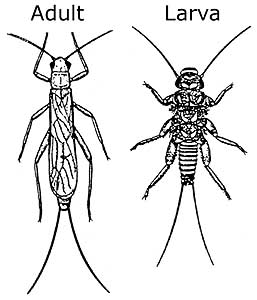BUG OF THE MONTH: March 1994
Stoneflies: Primitive Drummers
Copyright © 1994 by Louise
Kulzer
This article originally appeared in Scarabogram, March 1994,
New Series No. 167, pp. 2-3.
 Stoneflies,
order Plecoptera, are indeed intriguing insects. Of a very old and stable lineage,
the Plecoptera have changed very little since the Tertiary (66-1.6 million years
ago) (Illies 1965). Some believe that cold running water was their ancestral
home, contrary to many ecological theories which assume most evolutionary diversity
stems from the tropics (Williams & Feltmate 1992).
Stoneflies,
order Plecoptera, are indeed intriguing insects. Of a very old and stable lineage,
the Plecoptera have changed very little since the Tertiary (66-1.6 million years
ago) (Illies 1965). Some believe that cold running water was their ancestral
home, contrary to many ecological theories which assume most evolutionary diversity
stems from the tropics (Williams & Feltmate 1992).
Stoneflies are aquatic in the immature nymphal stage, with aerial adults that
are fairly short-lived. The word "nymph" should give you a clue -
stoneflies have direct metamorphosis, meaning they have no pupal resting stage.
The nymphal instars develop wing pads which enlarge with successive molts until
the final molt to adult. For this final transformation, the nymph crawls up
overhanging roots, vegetation or rocks protruding from the water, splits the
thorax, and crawls away as an adult.
Although most adults have typical wings, they are weak fliers. Some species
have reduced wings, and a few are wingless (Williams & Feltmate 1992). This
"home-body" tendency has led to local speciation. It also makes stoneflies
ideally suited to studies of biogeography.
Adults engage in an interesting behavior known as "drumming." When
drumming, stoneflies strike their last few abdominal segments against the substrate,
producing a signal of pulses and pauses. Both males and females have been observed
drumming (Stewart et al. 1982). Investigators have developed methods to record
stonefly drumming signals, much as ornithologists record bird songs. The number
of beats and beat interval are species specific, improving the efficiency of
mate-finding in an otherwise silent, drab, relatively sedentary insect.
The nymphs are, however, my favorite stage. As the name stonefly implies, they
typically crawl around under rocks in streams. The mouthpart structure of nymphs
directly reflects their food habits. Predatory species have developed pointed
lobes extending from the paraglossae. Non-predators generally have paraglossae
of about equal length to the glossae (see diagram). Since much of aquatic ecology
revolves around feeding niches, this is indeed a handy trait to display so prominently.
Nymphs are pollution intolerant, needing high oxygen content in the water.
They are almost always found either in flowing water or along shores of cold
water lakes. Nymphs have diagnostic finger-like gills on the neck, thorax, and
sometimes the abdomen to assist in oxygen uptake.
Though most stoneflies are relatively small, there is a genus of giant stonefly
which frequents streams in the maritime northwest. It has a 2-3 year life cycle,
the price it must pay to gain its large stature. I've seen giant stonefly nymphs
in the small streams draining Cougar Mountain, in the Soleduck River, and in
Mt. Rainier National Park. The best way for you to see these and other stonefly
nymphs is to pick up and examine hand-size rocks whenever you're near a river
or stream. Yes, even in winter!
References
Illies, J. 1965. Phylogeny and zoogeography of the Plecoptera.
Annual Review of Entomology, 10: 117-140.
Stewart, K.W., S.W.Szczytko, B.P.Stark, & D.D.Zeigler. 1982.
Drumming behavior of the six North American Perlidae (Plecoptera) species. Annals
of the Entomological Society of America, 75(5): 549-554.
Williams, D.D., & B.W. Feltmate. 1992. Aquatic insects. CAB
International, Wallingford, U.K.
This page last updated 16 June, 2005
 Stoneflies,
order Plecoptera, are indeed intriguing insects. Of a very old and stable lineage,
the Plecoptera have changed very little since the Tertiary (66-1.6 million years
ago) (Illies 1965). Some believe that cold running water was their ancestral
home, contrary to many ecological theories which assume most evolutionary diversity
stems from the tropics (Williams & Feltmate 1992).
Stoneflies,
order Plecoptera, are indeed intriguing insects. Of a very old and stable lineage,
the Plecoptera have changed very little since the Tertiary (66-1.6 million years
ago) (Illies 1965). Some believe that cold running water was their ancestral
home, contrary to many ecological theories which assume most evolutionary diversity
stems from the tropics (Williams & Feltmate 1992).